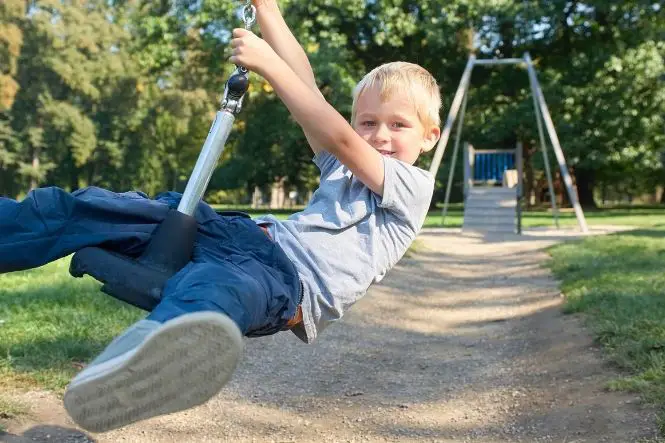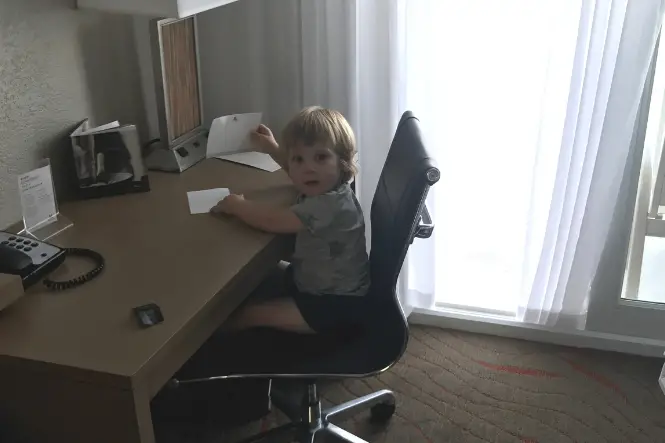Playbarns and indoor play areas are commonplace and rainy weekends are countered by visits to these large, purpose-built indoor play centres, such as those at the Wacky Warehouse pubs. While they are great fun, parents need to ensure that their children know the risks involved, and that if they misuse the equipment, then there is very little comeback if they are injured.
The same goes for outdoor play equipment, whether in your own garden or in a local park or playground. Obviously, common sense should prevail whatever your kids are playing on, but here are a few of the industry standards for you to bear in mind.
Table of Contents
Safety Standards: Domestic Gardens
Play surfaces for domestic gardens should comply with safety standard EN1177. Basically this means it should be self draining and non-slip in order to do things like safely stop muddy patches under swings. The surfaces are widely available from places like Toys-R-Us in metre square tile form (it costs about £14.99 per tile), which fit together easily. It is very effective and can help Prevent Injuries From Falls up to 2.4m.
When Choosing Play Equipment, such as climbing frames, swings and slides, for use in domestic gardens it has to satisfy the British Toy and Hobby Association to standard EN718. It should also display the CE and Lion mark as an indication that is has passed stringent tests and is safe to use (see below for information on safety marks).
Safety Standards: Public Areas
In public areas, such as parks and playgrounds, surfaces again have to comply with the EN1177 standard (as above), and are generally much more heavy duty and hardwearing. Most new playgrounds now come with heavy rubber tiles or playbark to the necessary depth (according to the equipment used).
Unfortunately, animals often use playbark as a toilet, so make sure you keep an eye open for that! It is possible to fence off a play area so that larger animals can’t get in there, but you’ll never stop smaller animals such as cats and squirrels from getting in.
It is generally now recognised that gravel is not a suitable surface for a play area. Sand, of the correct type, can be OK under the right conditions and depth. Sand is more likely to cause a hazard by being thrown or eaten by younger children, so supervision by parents in public playgrounds is a must.
Playbarns and Indoor Play Facilities
For big indoor soft play areas, it’s important to note that most reputable sites will have been approved at design or installation stage by RoSPA (Royal Society for the Prevention of Accidents) and that they will have had to satisfy a stringent set of tests to gain approval. You can always ask to see their inspection report if you are unsure.
They should also clearly display any restrictions or guidance for use of the equipment, so take a minute to check this out. If they haven’t displayed it, point out that they should.
In most sites, ages should be segregated and this should be enforced both ways to avoid injury through boisterous play to smaller children.
While supervision is normally by the parent, there should be at least one member of staff in the room to act as a supervisor of the play area and they shouldn’t be on the phone or having a chat, they should be watching. Most places will ensure that at least one member of staff is near by or in the apparatus with the children.
Disrepair can be a hazard and if the foam pads or padding are ripped, chunks of the foam can be a Choking Hazard. The foam pads also have to meet BS 5852 standards of fire resistance – although fire is a low risk, the high concentration of foam in one area means it would be highly flammable if it did catch fire.
The containment netting often found in the larger play areas can be dangerous as it can trap ankles or wrists and, if it is the wrong size, heads. The BS 4409 rules state that the netting should be easy to cut in case a child needs to be freed, and a standard size of 40-60mm should be used to best avoid this, roughly small enough to stop balls passing through but not so small as to reduce visibility.
Ball pits should be designed for minimum ball spillage, have surrounding netting and an easy open access. Junior ball pools should not be more than 600mm deep and toddler ball pools not more than 450mm deep so that children can remain clearly seen.
Indoor Play: What to Look For
In general, make sure that both the venue and you know that:
- Users should remove footwear (except socks) and any other hard dangerous objects, such as buckles and badges. Glasses are best removed because of the risk of collision with other children.
- Children should not eat, drink or chew gum on any indoor or outdoor equipment.
- The proprietors should have a height/age restriction in place, which parents and children should adhere to. If in a public place, make your own judgement on whether your child is on the appropriate bit of equipment for their age/ability.
- Don’t block entrances and exits or allow children to play in them, as access may need to be gained quickly.
- Don’t allow children to climb on the walls (the netting) of indoor play centres, and encourage good, safe, proper use of the equipment.
- Make sure staff know where first aid kits are and that someone has been trained to deal with basic injuries.
- Hygiene levels are adhered to. Believe it or not, urine and faeces are often found in soft play and ball pool areas, so these areas should be cleaned daily and a daily inspection carried out.For more information about the kite mark and CE mark see our safety marks article.







